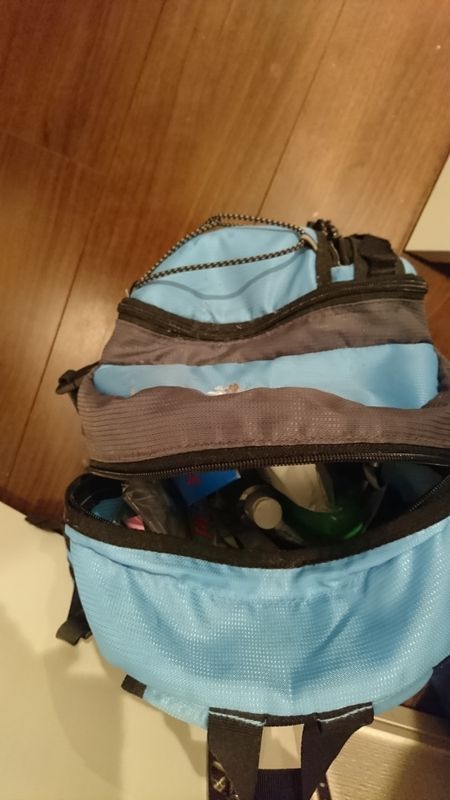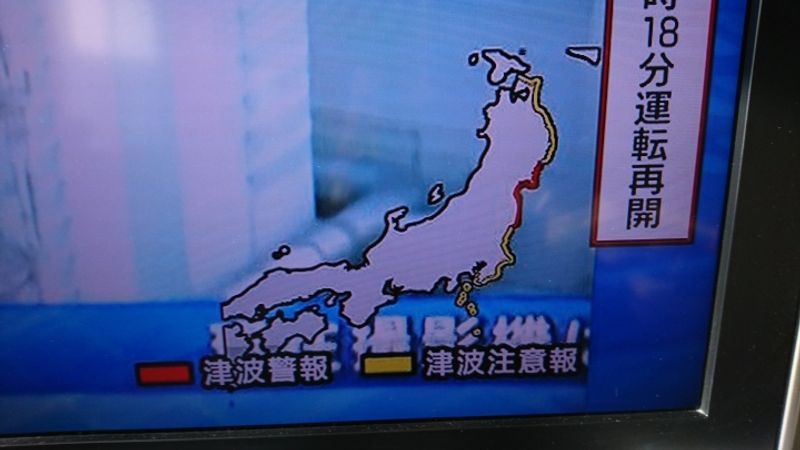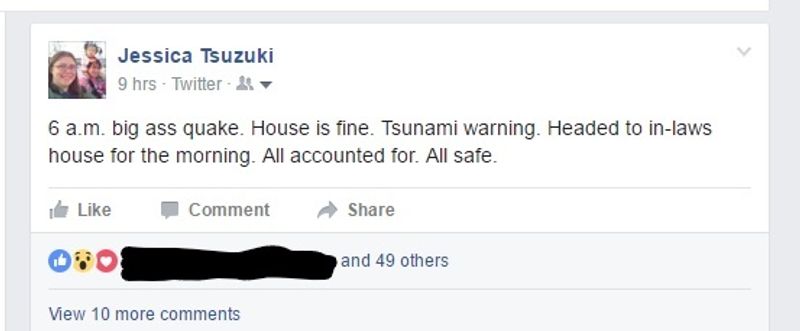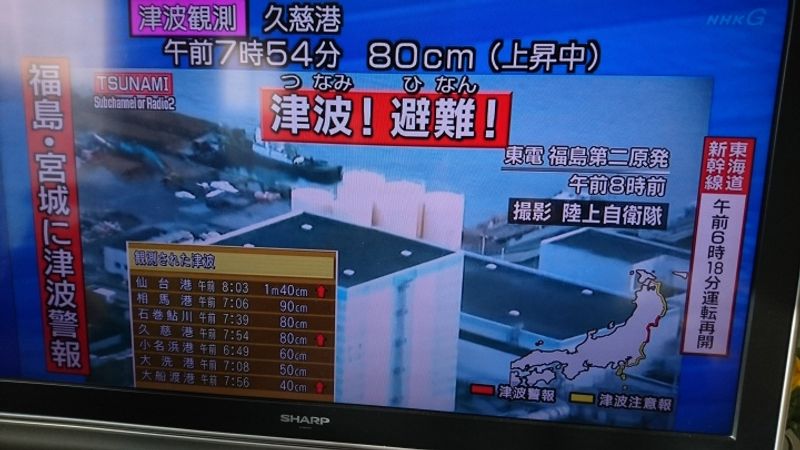Nov 22, 2016
10 Ways to Prepare for Japanese Quakes and Tsunamis
At 6AM this morning a Magnitude 7.4 earthquake struck outside of Fukushima prefecture. It was slightly less intense in Miyagi, where it still caused alarms and woke us up. Soon the tsunami sirens were going off and we were headed uphill and inland to my in-laws place to wait out the morning tsunami warning.
Unless you're from a quake-prone area, the threat of these common Japanese disasters can be really scary for the potential future Japanese resident. Here is a list of things to do to help you prepare for the unlikely scenario of a major quake and/or tsunami in Japan.
What happens when there’s a quake:
First, if it’s a major quake, your Japanese cell phone will make all sorts of ungodly noise, with a max-volume alarm going off no matter what mode the phone is in. This is to save your life, but the alarm will only sound a few seconds before the shaking starts.
Then there’s shaking. Usually it’ll end after a few seconds and your apartment will be almost exactly as it was before. If it lasts much longer, you can hide under a table or desk until it stops. If it's a big one, you'll likely want to leave the building and head to a more secure location at that time.
After the shaking stops, if you’re in an area close to the ocean, listen for more alarms and prepare to move to higher ground. Tsunamis can happen without an earthquake trigger, but any quake above a magnitude 7 is likely to cause some tsunami action. What do you do?
1) Stay Calm

Okay, maybe not that calm. This was my daughter this morning.
Freaking out over whatever is happening helps no one. I don’t know about you, but the more elevated my adrenaline, the less I can speak or understand Japanese. The less friendly or respectful I am to others. The less I can do to help myself or anyone else. The first thing you have to do is breathe. Then, if you’ve prepared properly, you should already know what to do next.
2) Have a Go Bag

Most long term residents do. A backpack or other bag, filled with a few liters of water, canned food, candles or glow sticks or other portable light source, batteries, and anything else you can imagine needing when you’re without running water, access to food, or electricity. Also include any vital documents like your passport and bank books. Keep it close to the front door, but out of the way, so you’re not always tripping over it but at the same time it’s ready to go and easy to grab. This is one of ours, from our hall closet.
3) Know Some Kanji

It is good to be familiar with the words themselves, like 津波 tsunami, 地震 jishin (earthquake), and
台風 taihu(typhoon). It is also beneficial to know the kanii for whatever town you are living in and as many of the surrounding areas as you can. This way, you'll be able to interpret the information in more difficult situations, even without a translation app.
4) Know Your Town

See that red dangly bit? That's Matsushima. We're just south of there, also in the red. Being able to pinpoint your town on a map of Japan can come in handy.
It is very useful to know more about your town than just the kanji and pronunciation. You should, shortly upon arrival, figure out if you’re close to the ocean or rivers and on low ground. Also, find out what parts of town have higher elevations than where you are and how to get there quickly on foot or by bike. Knowing you’re a few train stops away from safety isn’t always as useful as the trains won’t usually be running after a quake like that. They might be back up within a few hours, but in extreme cases, it might take a week or longer.
5) Have a Plan
After you know where the tsunami evacuation areas are, and where you can or should go, make out the plan in your mind. Walk the path a couple of times when you’re not running for your life so you know how to get where you need to get. Think about what you’ll need for at least a few days after a major catastrophic event and get that stuff in the go bag. Keep an eye on the expiration dates when you check the bag once a year or so.
6) Make Good Connections
Having friends in a other parts of Japan can make all the difference when things go south. My little adopted family survived partially by the grace of a few packages from friends in my former Japanese home, who were otherwise unaffected by the quake. At the same time, packages sent from abroad were being turned away, the postal services unsure of whether or not they could deliver to the tsunami affected areas. Also, it’s good to have friends in town who you can rely on in times of crisis, personal or otherwise.
7) Check In

If you’re in a town that gets hit with a major quake or tsunami, you can do the math to figure out when your friends and family back home will be awake to see the news, but the general rule of thumb I follow now (after the mag 9 knocked out power and cell phone towers, leaving my mom without word from me after the Mag 9, ruining her birthday among other things) is as soon as something happens and I know I’m okay, I try to get word out on Facebook or Twitter to let people know I’m safe.
8) Stay Safe
If you’re in a tsunami prone area, stay out for a good long while. Since the 2011 tsunami, the authorities have been more restrictive in when they tell people to head back to the affected areas. This is because a lot of people went home after the March 11 quake, expecting a small to normal sized tsunami, and never came back. So if you’re in a situation where you can run by your house, grab a few possessions and head to high ground, do it, and stay at that higher ground for a few hours. They’ll tell you when it’s safe to return.
9) Know When to Turn it Off

Already in your safe spot with your go bag? Ongoing coverage making your anxiety explode? Turn it off for a bit.
Just like with any other major news event of the last 20 years, you’re going to see the same footage over and over on TV. When you’re convinced that you’ve got as much information as you can use and continuing to watch for more is exhausting you, don’t feel bad about turning it off for a bit and watching something you want or doing some other things around the house or wherever you’re holed up. Staying hyper-vigilant and freaked out for too long is a drain on anyone. If you are in a safe, private place where it is possible, take a nap if you feel like it. Your phone will go off or the tsunami sirens (which sound a lot like tornado sirens) will go off if danger strikes. You’ll hear about it and are unlikely to sleep through it. When today's tsunami warning was lifted, our phones were sent an emergency message from the city, letting us know it was safe to go home.
10) Some Things Will Return to Normal; Some Things Won’t
Trains and other basic amenities generally come back fairly quickly, provided nothing has been wiped out or needed to be moved inland for tsunamis. The infrastructure here is great and it is tested for these things fairly regularly. Although life in general may appear much as it was just before the incident, some things will be different. Especially after a major event that causes such a huge death toll, communities will change. There will be turn over as some people will move away and others take their places. Things will change, but most shops will reopen and life will be very similar to before, even after a catastrophic occurrence like the magnitude 9.
Don’t discount what happens inside of you as well. Your mental health is important, and events like this can change how you feel. For about a year after the 2011 disasters, I couldn’t leave a cup or mug or dish anywhere but in a sink or in a closed cabinet for fear that they would fly off and break. I worked on getting over that and other post-quake mental issues by slowly acclimating to my new normal and forcing myself to hang pictures in frames on the wall, even though part of me just knew they would all fall. Some of them have. Most have stayed in place and helped me remember that not every day is quake day.
Living in Japan may mean dealing with the occasional quake. Most are so small you can’t feel them, but after you go through something like the magnitude 9, you can never fully ignore them again. You will wait for the shaking to stop to make sure it is a small one before moving on. Most of the time, you’ll only need to stand still for a second or two and it will be over, even in a fairly tall building. Other times, if you’ve prepared yourself, you’ll already know what to do.



3 Comments
SalarymanJim
on Nov 26
The NHK announcements for this earthquake were really strong, weren't they? The guy wasn't messing around with the way he was telling people to evacuate the area. After the earthquake in 2011 those phone 'earthquake' alarms really used to unnerve me. I suppose they still do now, although not so much. I've got a grab bag but haven't 'updated' it in ages. Something I should do.
JTsu
on Dec 14
@SalarymanJim Sorry for the delayed reply. I know what you mean. They never want to see anything like 311 again and I can't blame them. Better safe than sorry, though I would have preferred a morning in my own home. My go bag is a little out of date as well. Spam never really expires, right? *wink* *shudder*
SalarymanJim
on Dec 14
@JTsuzuki Mmm, if it (spam) was ever fit for purpose in the first place!! Yes, it's understandable after 311 that they don't want to take any chances.